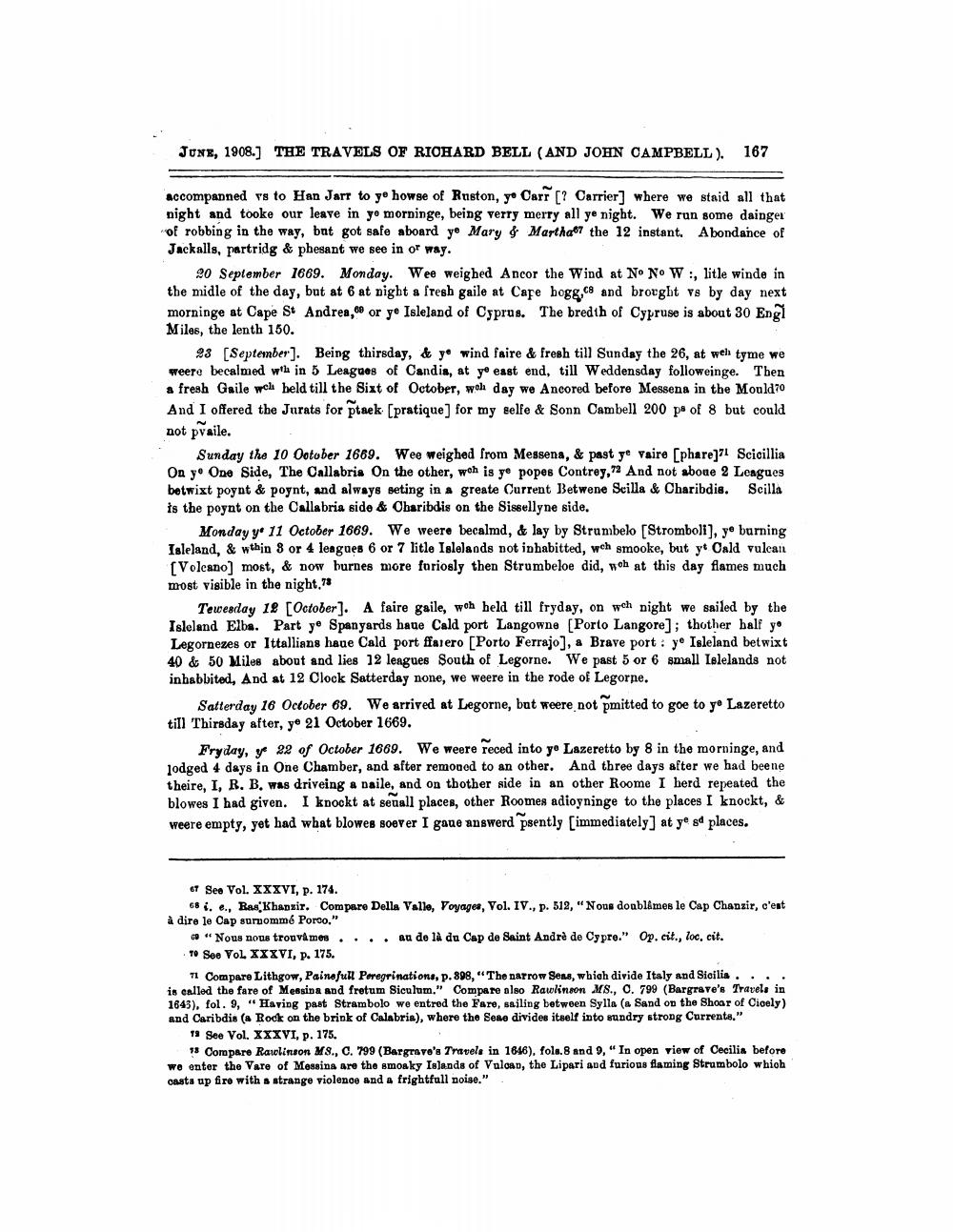________________
JONE, 1908.) THE TRAVELS OF RICHARD BELL (AND JOHN CAMPBELL). 167
accompagned ys to Han Jarr to ye howse of Ruston, y Cart ? Carrier] where we staid all that night and tooke our leave in yo morninge, being verry merry all ye night. We run some dainger of robbing in the way, but got safe aboard ye Mary ý Marthaor the 12 instant. Abondance of Jackalls, partridg & phesant we see in of way.
20 September 1669. Monday. Wee weighed Ancor the Wind at No No W:, litle winde in the midle of the day, but at 6 at night a fresh gaile at Cafe bogg,ce and brought vs by day next morninge at Cape St Andrea, or ye Isleland of Cyprus. The bredth of Cypruse is about 30 Eng Miles, the lenth 150.
93 September). Being thirsday, & ye wind faire & fresh till Sunday the 26, at wel tyme we weere becalmed with in 5 Leagues of Candis, at y east end, till Weddensday followeinge. Then a fresh Gaile wel beld till the Sixt of October, woh day we Ancored before Messena in the Mould70 And I offered the Jurats for ptaek (pratique] for my selfe & Sonn Cambell 200 på of 8 but could not pvaile.
Sunday the 10 October 1669. Wee weighed from Messena, & past ye vaire (phare]?l Scicillia On ye One Side, The Callabris On the other, woh is ye popes Contrey,72 And not aboue 2 Leagues betwixt poynt & poynt, and always seting in a greate Current Betwene Scilla & Charibdis. Scilla is the poynt on the Callabria side & Oharibdis on the Sissellyne side.
Monday y 11 October 1669. We weere becalmd, & lay by Strumbelo [Stromboli), ye burning Isleland, & wthin 8 or 4 leagues 6 or 7 litle Islelaods not inhabitted, wch smooke, but y Oald vulcan [Volcano) most, & now burnes more foriosly then Strumbeloe did, woh at this day flames much most visible in the night.78
Tewesday 18 [October]. A faire gaile, woh held till fryday, on wh night we sailed by the Isleland Elba. Part yo Spanyards haue Cald port Langowne [Porto Langore]; thother half yo Legornezes or Ittallians haue Cald port ffarero [Porto Ferrajo), a Brave port: yo Isleland betwixt 40 & 50 Miles about and lies 12 leagues South of Legorne. We past 5 or 6 small Lelelands not inhabbited, And at 12 Clock Satterday none, we weere in the rode of Legorre.
Satterday 16 October 69. We arrived at Legorne, but weere not pmitted to goe to ye Lazeretto till Thirsday after, ye 21 October 1669.
Fryday, y 22 of October 1669. We weere reced into yo Lazeretto by 8 in the morninge, and jodged 4 days in One Chamber, and after removed to an other. And three days after we had beene theire, I, R. B. was driveing a Daile, and on thother side in an other Roome I herd repeated the blowes I had given. I knockt at seuall places, other Roomes adioyninge to the places I knockt, & weere empty, yet had what blowes soever I gaue answerd "psently [immediately] at ye gd places.
61 Ses Vol. XXXVI, p. 174.
68 i, e., Ras Khanxir. Compare Della Valle, Voyages, Vol. IV., p. 512, "Nous doablêmes le Cap Chanzir, c'est à dire le Cap soruommé Porco."
"Nous nous trouvámes .... an de là du Cap de Saint Andrè de Cypre." Op.cit., loc. cit. To See YoL XXXVI, p. 175.
71 Compare Lithgow, Painofull Peregrinations, p.898, "The narrow Seas, which divide Italy and Sicilia ... is called the fare of Messina and fretum Siculum." Compare also Rawlinson Ms., O. 799 (Bargrave's Travels in 1643), fol. 9, "Having past Strambolo we entred the Fare, sailing between Sylla (a Sand on the Shoar of Cicely) and Caribdis (a Rock on the brink of Calabria), where the Seas divides itself into sundry strong Currents."
TI See Vol. XXXVI, p. 175.
3 Compare Railinson M8., 0.799 (Bargrave's Travels in 1646), folo. 8 and 9,"In open view of Cecilia before we enter the Vare of Messina are the smoaky Islands of Vuloar, the Lipari and furious flaming Strumbolo whioh oasts up fire with a strange violence and a frightfull noise." .




